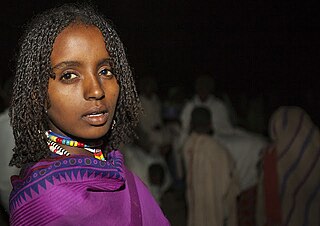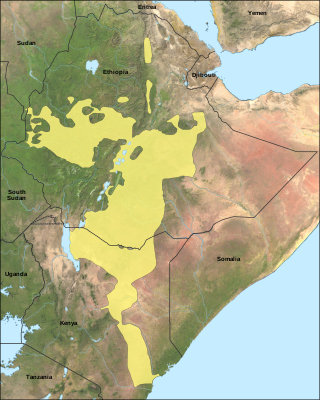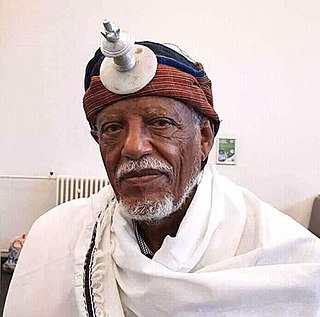
The Oromo people are a Cushitic ethnic group native to the Oromia region of Ethiopia and parts of Northern Kenya. They speak the Oromo language, which is part of the Cushitic branch of the Afroasiatic language family. They are one of the largest ethnic groups in Ethiopia. According to the last Ethiopian census of 2007, the Oromo numbered 25,488,344 people or 34.5% of the Ethiopian population. Recent estimates have the Oromo comprising 45,000,000 people, or 35.8% of the total Ethiopian population estimated at 116,000,000.

The government of Ethiopia is the federal government of Ethiopia. It is structured in a framework of a federal parliamentary republic, whereby the prime minister is the head of government. Executive power is exercised by the government. The prime minister is chosen by the lower chamber of the Federal Parliamentary Assembly. Federal legislative power is vested in both the government and the two chambers of parliament. The judiciary is more or less independent of the executive and the legislature. They are governed under the 1995 Constitution of Ethiopia. There is a bicameral parliament made of the 108-seat House of Federation and the 547-seat House of Peoples' Representatives. The House of Federation has members chosen by the regional councils to serve five-year terms. The House of Peoples' Representatives is elected by direct election, who in turn elect the president for a six-year term.

Oromo, historically also called Galla, is an Afroasiatic language that belongs to the Cushitic branch. It is native to the Ethiopian state of Oromia and Northern Kenya and is spoken predominantly by the Oromo people and neighboring ethnic groups in the Horn of Africa. It is used as a lingua franca particularly in the Oromia Region and northeastern Kenya.

Oromia is a regional state in Ethiopia and the homeland of the Oromo people. Under Article 49 of Ethiopian Constitution, the capital of Oromia is Addis Ababa, also called Finfinne. The provision of the article maintains special interest of Oromia by utilizing social services and natural resources of Addis Ababa.

Under the current constitution, Ethiopia conducts local, regional, and federal elections. At the federal level, Ethiopia elects a legislature. The Federal Parliamentary Assembly has two chambers: the House of People's Representatives with not more than 550 members as per the constitution but actually nearly 547 members, elected for five-year terms in single-seat constituencies; and the Council of the Federation with 117 members, one each from the 22 minority nationalities, and one from each professional sector of its remaining nationalities, designated by the regional councils, which may elect them themselves or through popular elections.

The Boorana are one of the two major subgroups of the Oromo people. A Cushitic ethnic group, they primarily inhabit the Borena Zone of the Oromia Region of Ethiopia and the former Eastern Province in northern Kenya, specifically Marsabit County. They speak a distinct dialect of the Oromo language by the same name, Boorana. The Boorana people are notable for practicing the Gadaa system without interruption.
Barento is one of the two major subgroups of the Oromo people, a Cushitic ethnic group. They live in the West Hararghe Zone, East Hararghe Zone, Arsi zone, of the Oromia Region of Ethiopia while the other subgroup named Borana Oromo inhabiting Oromia Special Zone Surrounding Addis Ababa, West Shewa Zone, West Welega Zone and Borena Zone of the Oromia Region of Ethiopia.

The Oromo Liberation Front is an Oromo nationalist political party formed in 1973 to promote self-determination for the Oromo people inhabiting today's Oromia Region and Oromia Zone in the Amhara Region of Ethiopia. The OLF has offices in Addis Ababa, Washington, D.C., and Berlin, from which it operates radio stations that broadcast in Amharic and Oromo.
Galamso, is a town in West Haraghe of Oromia Region, Ethiopia, Gelemso is located in eastern Ethiopian and is far from country capital by 301 km and second way 413 km in the western periphery of the highly networked mountain chain referred to by the natives as Fugug and by geographers as the Ahmar Mountains. Most people say that it is the city of love locally [Biyyaa Jaalala]. Gelemso on 2013 EC became separate woreda in the West Hararghe Zone of the Oromia Regional State, it has a latitude and longitude of 8°49′N40°31′E. Gelemso is the origin of a variety of Jimaa called by the same name (Gelemso).

The Islamic Front for Liberation of Oromia was an Oromo-based political and paramilitary organization founded in 1985 by its Commander in Chief, Sheikh Abdulkarim Ibrahim Hamid, otherwise known as Jaarraa Abbaa Gadaa.
The Gedeo are an ethnic group in southern Ethiopia. The Gedeo Zone in the Southern Nations, Nationalities, and People's Region (SNNPR) is named for this people. They speak the Gedeo language, which is one of the Cushitic languages.
The Borana calendar is a calendrical system once thought to have been used by the Borana Oromo, a people living in southern Ethiopia and northern Kenya. The calendar has been claimed to be based on an earlier Cushitic calendar, developed around 300 BC found at Namoratunga. However, reconsideration of the Namoratunga site led astronomer and archaeologist Clive Ruggles to conclude that there is no relationship. The Borana calendar consist of 29.5 days and 12 months for a total 354 days in a year. The calendar has no weeks but name for each day of the month. It is a lunar-stellar calendar system.

Medrek, officially the Ethiopia Federal Democratic Unity Forum, is an Ethiopian political coalition founded in 2008 by former defense minister Siye Abraha and former president Negasso Gidada. The election symbol of the party is five fingers. On 2008 election, Medrek won a single seat in the House of Peoples' Representatives, representing an electoral district in Addis Ababa. This was allegedly due to lack of election transparency. Medrek won 30% of the individual vote nationwide but received only one seat in parliament since Ethiopia's elections are conducted under a single-member plurality voting system.
The Machaa are a subgroup of the Oromo people in western and Central Oromia. They live south of the Blue Nile (Abbai) in the northwestern part of the region of Oromia and in parts of West Shewa Zone, South West Shewa Zone, Oromia Special Zone Surrounding Finfinnee, West Welega Zone, East Welega Zone, Jimma, Jimma Zone, Illubabor Zone, Kelam Welega Zone,Horo Guduru and in parts Amhara Region particularly Gojjam zones. A small group of them lives in the area north of the Blue Nile Wambara in the Benishangul-Gumuz Region.
Lencho Letta is an Ethiopian politician and Oromo activist who was founding member of Oromo Liberation Front (OLF). He was the Deputy Secretary General of the Oromo Liberation Front (OLF) from 1974 to 1995. In Late 1990s, Lencho left OLF leadership due to ideological differences. He is currently the leader of Oromo Democratic front, which was formed in 2013.

The Oromo Liberation Army is an armed opposition group active in the Oromia Region of Ethiopia. The OLA consist primarily of former armed members of the pre-peace deal Oromo Liberation Front (OLF) who refused to disarm out of skepticism of the peace deal, and former youth protestors who grew disillusioned with nonviolent resistance.

The Oromo conflict is a protracted conflict between the Oromo Liberation Front (OLF) and the Ethiopian government. The Oromo Liberation Front formed to fight the Ethiopian Empire to liberate the Oromo people and establish an independent state of Oromia. The conflict began in 1973, when Oromo nationalists established the OLF and its armed wing, the Oromo Liberation Army (OLA). These groups formed in response to prejudice against the Oromo people during the Haile Selassie and Derg era, when their language was banned from public administration, courts, church and schools, and the stereotype of Oromo people as a hindrance to expanding Ethiopian national identity.
Waaqeffanna is an ethnic religion indigenous to the Oromo people in the Horn of Africa. The word Waaqeffanna is derived from Waaq which is the ancient name for the Creator in the Cushitic languages of both the Oromo people and Somali people in the Horn of Africa. The followers of the Waaqeffanna religion are called Waaqeffataa and they believe in the supreme being Waaqa Tokkicha. It is estimated that about 3% of the Oromo population, which is 1,095,000 Oromos, in present day Ethiopia actively practice this religion. Some put the number around 300,000, depending on how many subsets of the religion one includes. This number is still up for debate by many African religious scholars.

Customary laws, in line with official state laws, are based on age-old community customs and norms in Ethiopia. They are noticeable in regional states and become influential in the life of people more than the formal legal system. For example, in Amhara Region, they are called "Shemagelle", in Tigray "Bayito" and "Abo Gereb", and "Luba Basa" in Oromia.

Oromo nationalism is an ethnic nationalism advocating the self-interest of Oromo people in Ethiopia and Kenya. Many Oromo elites, intellectuals and political leaders struggled to create an independent Oromia state throughout 19th and 20th century, since the start of Abyssinian colonialism under Emperor Menelik II. No consensus has been reached yet regarding the motives of this type of nationalism, whether the Oromos librate themselves to form a nation-state or offer self-determination in federal Ethiopia.











